Practice International trade Task № 1 Consider
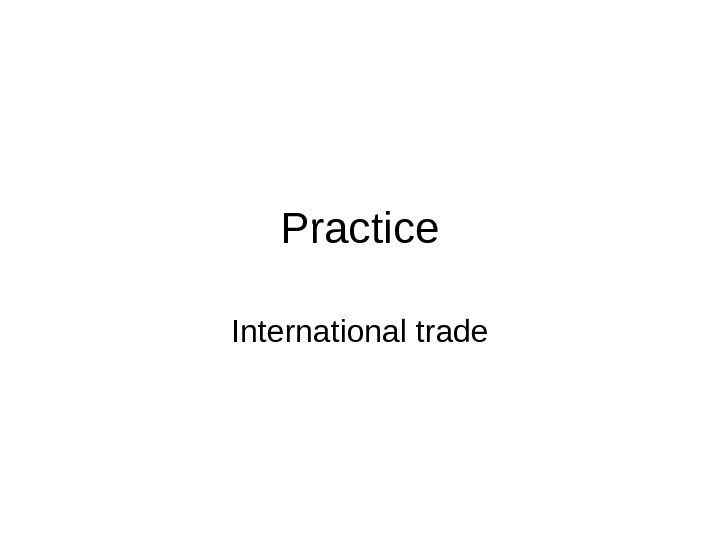

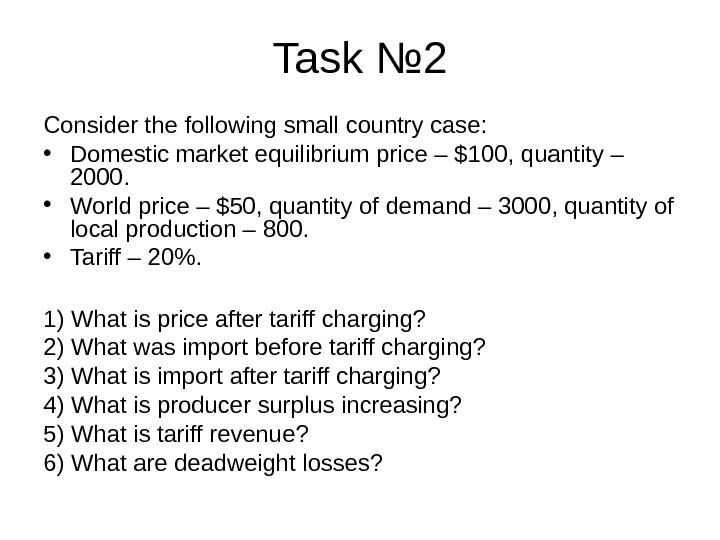
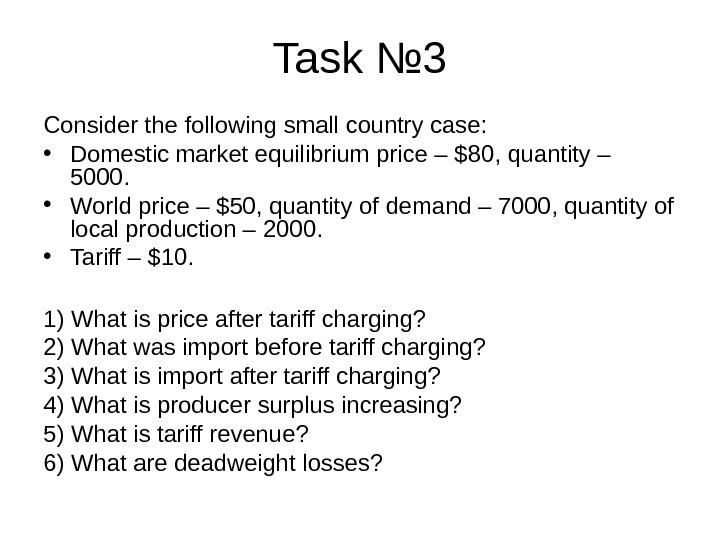
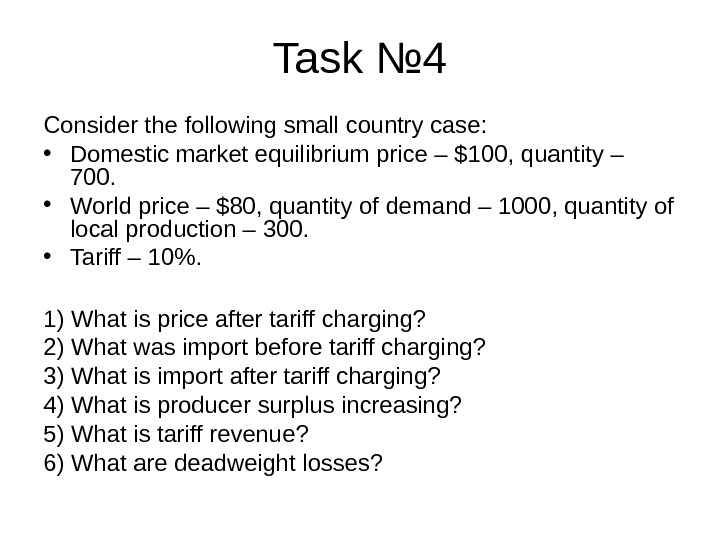
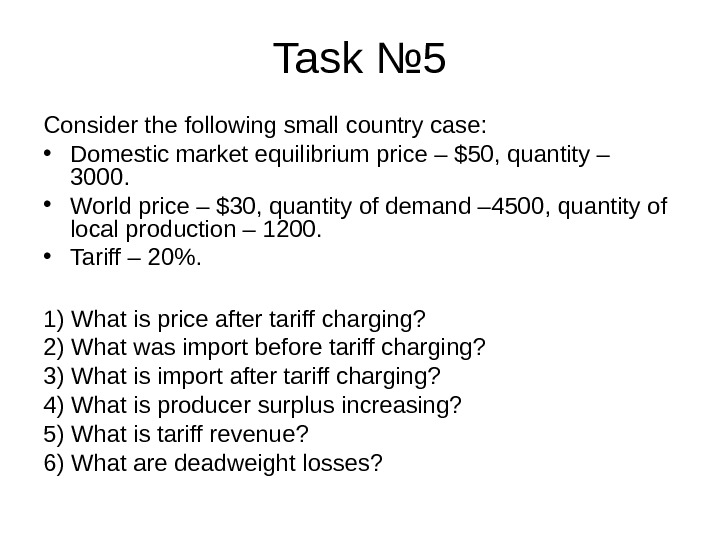
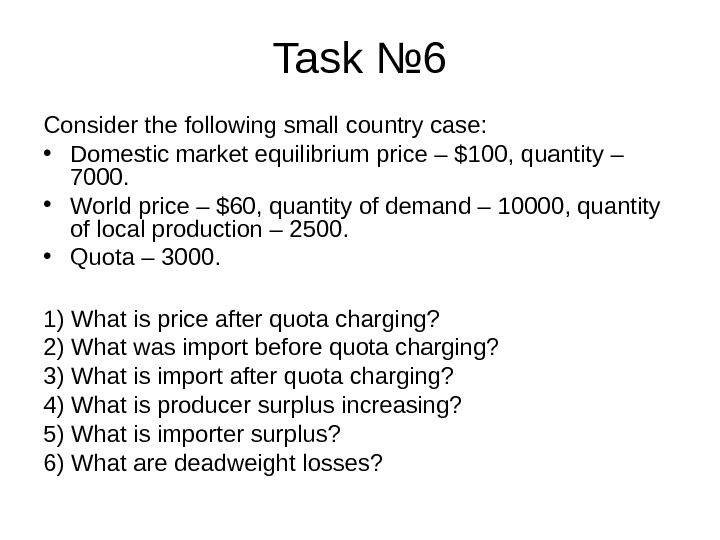
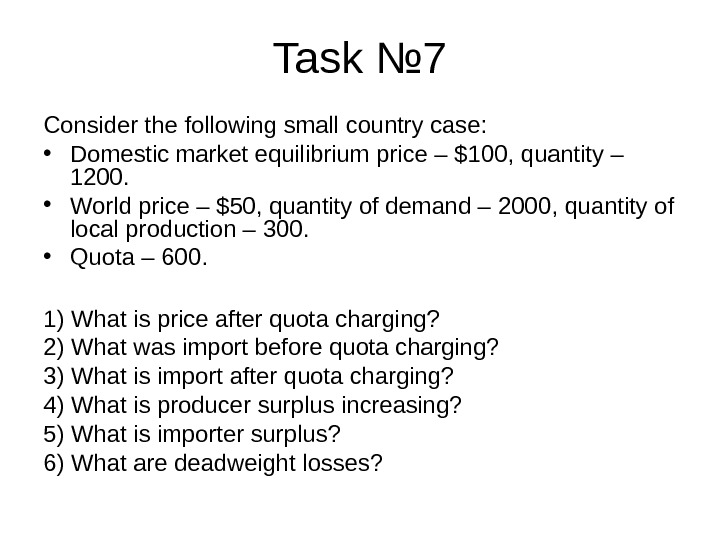
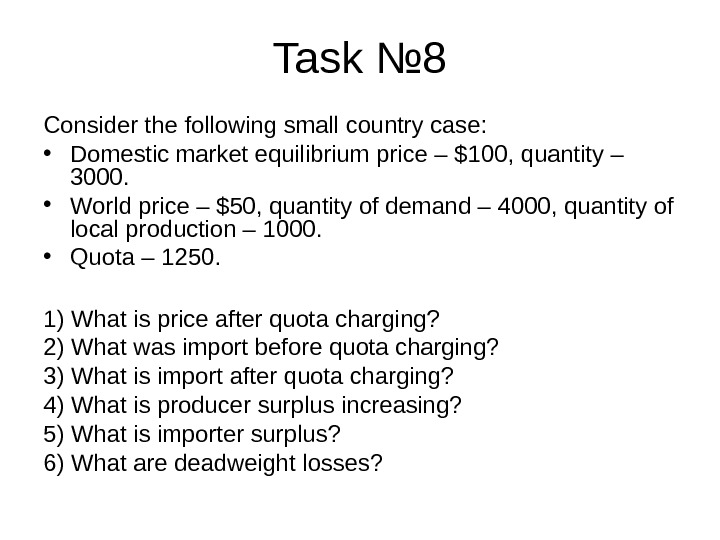
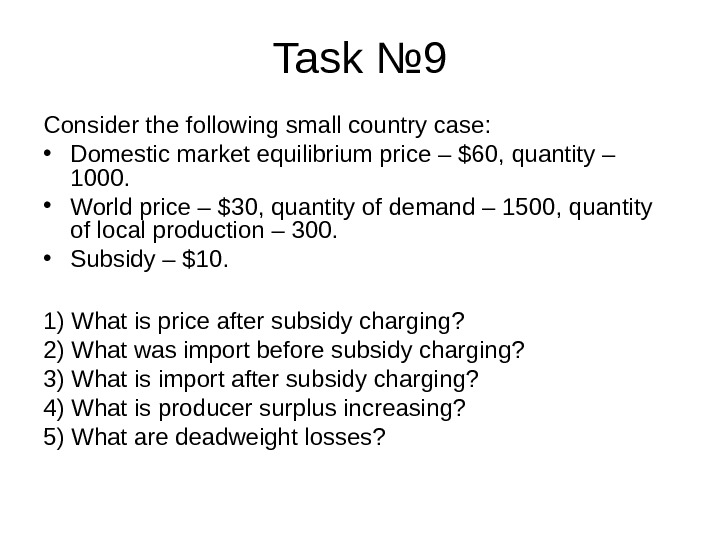

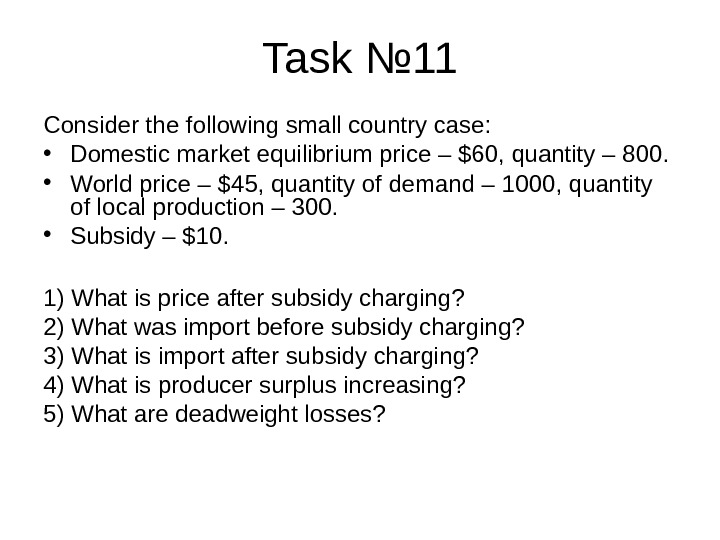
- Размер: 124 Кб
- Количество слайдов: 12
Описание презентации Practice International trade Task № 1 Consider по слайдам
 Practice International trade
Practice International trade
 Task № 1 Consider the following small country case: • Domestic market equilibrium price – $60, quantity – 3000. • World price – $30, quantity of demand – 5000, quantity of local production – 1000. • Tariff – $5. 1) What is price after tariff charging? 2) What was import before tariff charging? 3) What is import after tariff charging? 4) What is producer surplus increasing? 5) What is tariff revenue? 6) What are deadweight losses?
Task № 1 Consider the following small country case: • Domestic market equilibrium price – $60, quantity – 3000. • World price – $30, quantity of demand – 5000, quantity of local production – 1000. • Tariff – $5. 1) What is price after tariff charging? 2) What was import before tariff charging? 3) What is import after tariff charging? 4) What is producer surplus increasing? 5) What is tariff revenue? 6) What are deadweight losses?
 Task № 2 Consider the following small country case: • Domestic market equilibrium price – $ 10 0, quantity – 2 000. • World price – $ 5 0, quantity of demand – 3 000, quantity of local production – 8 00. • Tariff – 20%. 1) What is price after tariff charging? 2) What was import before tariff charging? 3) What is import after tariff charging? 4) What is producer surplus increasing? 5) What is tariff revenue? 6) What are deadweight losses?
Task № 2 Consider the following small country case: • Domestic market equilibrium price – $ 10 0, quantity – 2 000. • World price – $ 5 0, quantity of demand – 3 000, quantity of local production – 8 00. • Tariff – 20%. 1) What is price after tariff charging? 2) What was import before tariff charging? 3) What is import after tariff charging? 4) What is producer surplus increasing? 5) What is tariff revenue? 6) What are deadweight losses?
 Task № 3 Consider the following small country case: • Domestic market equilibrium price – $ 80 , quantity – 5 000. • World price – $ 5 0, quantity of demand – 7 000, quantity of local production – 20 00. • Tariff – $ 10. 1) What is price after tariff charging? 2) What was import before tariff charging? 3) What is import after tariff charging? 4) What is producer surplus increasing? 5) What is tariff revenue? 6) What are deadweight losses?
Task № 3 Consider the following small country case: • Domestic market equilibrium price – $ 80 , quantity – 5 000. • World price – $ 5 0, quantity of demand – 7 000, quantity of local production – 20 00. • Tariff – $ 10. 1) What is price after tariff charging? 2) What was import before tariff charging? 3) What is import after tariff charging? 4) What is producer surplus increasing? 5) What is tariff revenue? 6) What are deadweight losses?
 Task № 4 Consider the following small country case: • Domestic market equilibrium price – $ 10 0, quantity – 700. • World price – $ 8 0, quantity of demand – 1 000, quantity of local production – 3 00. • Tariff – 10%. 1) What is price after tariff charging? 2) What was import before tariff charging? 3) What is import after tariff charging? 4) What is producer surplus increasing? 5) What is tariff revenue? 6) What are deadweight losses?
Task № 4 Consider the following small country case: • Domestic market equilibrium price – $ 10 0, quantity – 700. • World price – $ 8 0, quantity of demand – 1 000, quantity of local production – 3 00. • Tariff – 10%. 1) What is price after tariff charging? 2) What was import before tariff charging? 3) What is import after tariff charging? 4) What is producer surplus increasing? 5) What is tariff revenue? 6) What are deadweight losses?
 Task № 5 Consider the following small country case: • Domestic market equilibrium price – $50, quantity – 30 00. • World price – $30, quantity of demand – 4500, quantity of local production – 1200. • Tariff – 2 0%. 1) What is price after tariff charging? 2) What was import before tariff charging? 3) What is import after tariff charging? 4) What is producer surplus increasing? 5) What is tariff revenue? 6) What are deadweight losses?
Task № 5 Consider the following small country case: • Domestic market equilibrium price – $50, quantity – 30 00. • World price – $30, quantity of demand – 4500, quantity of local production – 1200. • Tariff – 2 0%. 1) What is price after tariff charging? 2) What was import before tariff charging? 3) What is import after tariff charging? 4) What is producer surplus increasing? 5) What is tariff revenue? 6) What are deadweight losses?
 Task № 6 Consider the following small country case: • Domestic market equilibrium price – $ 10 0, quantity – 7000. • World price – $60, quantity of demand – 10000, quantity of local production – 2500. • Quota – 3000. 1) What is price after quota charging? 2) What was import before quota charging? 3) What is import after quota charging? 4) What is producer surplus increasing? 5) What is importer surplus? 6) What are deadweight losses?
Task № 6 Consider the following small country case: • Domestic market equilibrium price – $ 10 0, quantity – 7000. • World price – $60, quantity of demand – 10000, quantity of local production – 2500. • Quota – 3000. 1) What is price after quota charging? 2) What was import before quota charging? 3) What is import after quota charging? 4) What is producer surplus increasing? 5) What is importer surplus? 6) What are deadweight losses?
 Task № 7 Consider the following small country case: • Domestic market equilibrium price – $ 10 0, quantity – 1200. • World price – $50, quantity of demand – 2000 , quantity of local production – 300. • Quota – 600. 1) What is price after quota charging? 2) What was import before quota charging? 3) What is import after quota charging? 4) What is producer surplus increasing? 5) What is importer surplus? 6) What are deadweight losses?
Task № 7 Consider the following small country case: • Domestic market equilibrium price – $ 10 0, quantity – 1200. • World price – $50, quantity of demand – 2000 , quantity of local production – 300. • Quota – 600. 1) What is price after quota charging? 2) What was import before quota charging? 3) What is import after quota charging? 4) What is producer surplus increasing? 5) What is importer surplus? 6) What are deadweight losses?
 Task № 8 Consider the following small country case: • Domestic market equilibrium price – $ 10 0, quantity – 3000. • World price – $50, quantity of demand – 4000, quantity of local production – 1000. • Quota – 1250. 1) What is price after quota charging? 2) What was import before quota charging? 3) What is import after quota charging? 4) What is producer surplus increasing? 5) What is importer surplus? 6) What are deadweight losses?
Task № 8 Consider the following small country case: • Domestic market equilibrium price – $ 10 0, quantity – 3000. • World price – $50, quantity of demand – 4000, quantity of local production – 1000. • Quota – 1250. 1) What is price after quota charging? 2) What was import before quota charging? 3) What is import after quota charging? 4) What is producer surplus increasing? 5) What is importer surplus? 6) What are deadweight losses?
 Task № 9 Consider the following small country case: • Domestic market equilibrium price – $60, quantity – 1000. • World price – $30, quantity of demand – 1500, quantity of local production – 300. • Subsidy – $10. 1) What is price after subsidy charging? 2) What was import before subsidy charging? 3) What is import after subsidy charging? 4) What is producer surplus increasing? 5) What are deadweight losses?
Task № 9 Consider the following small country case: • Domestic market equilibrium price – $60, quantity – 1000. • World price – $30, quantity of demand – 1500, quantity of local production – 300. • Subsidy – $10. 1) What is price after subsidy charging? 2) What was import before subsidy charging? 3) What is import after subsidy charging? 4) What is producer surplus increasing? 5) What are deadweight losses?
 Task № 10 Consider the following small country case: • Domestic market equilibrium price – $45, quantity – 7000. • World price – $30, quantity of demand – 10000, quantity of local production – 3000. • Subsidy – $10. 1) What is price after subsidy charging? 2) What was import before subsidy charging? 3) What is import after subsidy charging? 4) What is producer surplus increasing? 5) What are deadweight losses?
Task № 10 Consider the following small country case: • Domestic market equilibrium price – $45, quantity – 7000. • World price – $30, quantity of demand – 10000, quantity of local production – 3000. • Subsidy – $10. 1) What is price after subsidy charging? 2) What was import before subsidy charging? 3) What is import after subsidy charging? 4) What is producer surplus increasing? 5) What are deadweight losses?
 Task № 11 Consider the following small country case: • Domestic market equilibrium price – $60, quantity – 800. • World price – $45, quantity of demand – 1000, quantity of local production – 300. • Subsidy – $10. 1) What is price after subsidy charging? 2) What was import before subsidy charging? 3) What is import after subsidy charging? 4) What is producer surplus increasing? 5) What are deadweight losses?
Task № 11 Consider the following small country case: • Domestic market equilibrium price – $60, quantity – 800. • World price – $45, quantity of demand – 1000, quantity of local production – 300. • Subsidy – $10. 1) What is price after subsidy charging? 2) What was import before subsidy charging? 3) What is import after subsidy charging? 4) What is producer surplus increasing? 5) What are deadweight losses?
